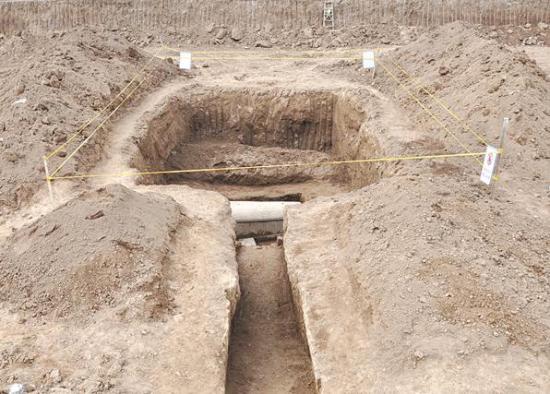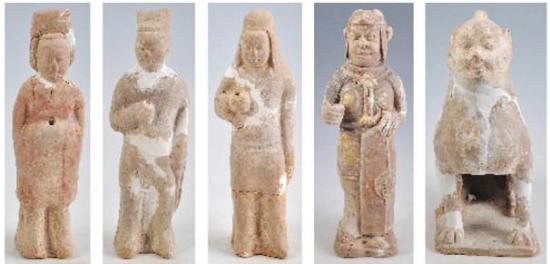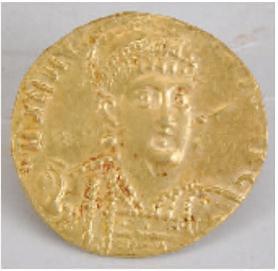Chinese Institute of Archaeology
Source - http://www.kaogu.cn/en/detail.asp?ProductID=4432
From June 2010 to August 2012, Institute of archaeology and Cultural Heritage protection in Xi’an has cleared and excavated four tombs dating back to the Northern Zhou dynasty; the site lies in the west to Gaowangdui village, Chang’an district, Xi’an city. Among them, three out of four are chronological tombs: Tomb of Zhang Wei (M11, in the second year of Tianhe, equivalent to AD567), tomb of Zhang Zheng (M4, in the first year of Jiande, AD572), and that of Zhang Sheng (M2, in the sixth year of Tianhe, AD571). Belonging to a single family, they all date to the Northern Zhou dynasty. From the tombs has been excavated many burial goods, including terracotta figurines, bronze mirrors and stone coffins.

Tomb of Zhang family
Tomb of Zhang Wei lies from south to north, and is single cave-chambered tomb with a long sloping passage. The tomb is composed of four parts: sloping passage, vaulted passage, sealed gate and burial chambers. The sloping passage is trapezoidal in shape, with the southern side wider than the northern. The whole passage is measured 7 meters horizontally in length, 1.24 meter wide in the southern side, 0.88 meter wide in the northern; the slope is 8-meter long and 4.9 meter deep. The vaulted passage is cave-like with arch roof, with 0.6 meter long, 1.24 meter wide and 1.4-meter high. Seating on the southern end of the vaulted passage, the sealed gate is built with two rows of blue bricks, which are horizontally lined in a way that each brick interlocks with another. The burial chamber is square in shape, with 2 meters in length (south-north), 2.14 meters in width (east-west) and 1.6 meters in height. The ceiling has long collapsed, but judging from what still remains, it should be a vault. This tomb has been suffered from grave robbery in an earlier date, remaining a robber hole in the roof of the vaulted passage with a 0.76-meter diameter. Inside the chamber there is no trace of the coffins; human skeletons are scattered in the northwestern part of the chamber, so neither the burial structure nor the tomb furniture can be identified. The team has found bronze coins, iron mirror and an epitaph, with the first two situated in the northwestern part and the epitaph around the entrance of the chamber.

Bronze mirror from the tomb
According to the epitaph, Zhang Wei had three sons: Jing Zhun (i.e. Zhang Zheng), Jing Bao, and Jing Xing (i.e. Zhang Sheng)
Zhang Sheng’s tomb seats 30 meters west to his father’s. It’s also single cave-chambered tomb with a long sloping passage, and runs from north to south. 甲-shaped in plan, the tomb is composed of three parts: sloping passage—which is the southernmost, vaulted passage and the northernmost burial chamber. Similar to Zhang Wei’s, the sloping passage is also trapezoidal in shape, with the southern side wider than the northern. The whole passage is measured 4.9-meter long on the slope, 1.2-meter wide on the southern side and 1-meter wide on the northern. The vaulted passage is a rectangular in plan with vaulted ceiling. Its length measures 0.5 meters, and its width 1.42 meters; the entrance is sealed with adobes. Lying perpendicular to the passage, the burial chamber is rectangular as well as vaulted. It is 2.42-meter long from west to east, and 2.16-meter from south to north. What remains of the walls is measured 1.1-meter high. Within the dirt and muds inside the chamber haven been found traces of decayed coffins, but it is not possible to estimate its original size due to the severe damage. Two skulls are found in the northwestern corner of the chamber, along with many other human remains scatted around. This tomb has been robbed and severely disturbed, so the team has found nothing but an iron door knocker with animal head, a silver hairpin and an epitaph.
The tomb of Zhang Zheng is oriented 25 meters west to that of Zhang Sheng. It’s also single cave-chambered tomb with a long sloping passage, and runs from north to south. 甲-shaped in plan, it is composed of the following parts from the northernmost to the southernmost: sloping passage, tunnel, vertical air-shaft, vaulted passage and burial chamber; the total measurement is 11.52 meters in length with the burial chamber as 5.6 meters in depth. The sloping passage is trapezoidal, with the southern side wider than the northern. The passage is 3.3-meter long, 1.3-meter wide on the southern side, and 0.9-meter wide on the northern. The slope measures 1.7 meters in length, with a 1.3-meter-wide in base. The vaulted passage is shaped in a trapezoid with the northern side slightly wider than the southern. It is 0.8-meter long, 1.4-meter wide on the northern, and 1.3-meter wide on the southern. The burial chamber is a vaulted rectangle perpendicular to the passage; it measures 3.3-meter long from east to west, and 2.5-meter from south to north. The remaining walls are 1.2 meters high.

Terracotta figurine from the tomb
From the vaulted passage and the southern part of the chamber the team has found terracotta figurine, pottery wells (jing), stove range (zao), grain grinder (mo), pestle (dui) and an epitaph. Among the terracotta figurine there are warriors, tomb-guarding beasts, hooded figurines (feng mao), longguan-figurines, riders and maid figurines with sieves.

Byzantine coin from the tomb
In the northern part of the chamber lies a sarcophagus. Heading from east to west, it is 2.2 meters long, 1.01 meters wide and 1.12 meters high. The sarcophagus is composed of lid, bottom, end panels at both head and feet, and two protective boards at south and north sides. The lid is arc-shaped, with four lotuses and a beast head incised on it. The end panel at the head is decorated with the Scarlet Bird (one of the four supernatural beings), while the panel at the feet with the Somber Warrior (one of the four supernatural beings); the Green Dragon (one of the four supernatural beings) on the northern protective board, and the White Tiger (one of the four supernatural beings) on the southern protective board. There are three human skeletons inside the coffin, together with a bronze mirror and a Byzantine coin.
M3 lies parallel to the tombs of Zhang Sheng and Zhang Zheng; it seats 10 meters east to Zhang Sheng’s tomb and 15 meters west to Zhang Zheng’s. It’s also single cave-chambered tomb with a long sloping passage, and runs from north to south. 甲-shaped in plan, it is composed of three parts from the southernmost to the northernmost: sloping passage, vaulted passage and burial chamber. The sloping passage is wider on the southern side (1.3 meters) and shorter on the northern (1.2 meters); the total length measures 3.9 meters; it has been filled with yellow-brown mottled soil. The vaulted passage appears rectangular in plan. Vaulted roof, it is 0.6 meters long, 1.4 meters wide and what remains of the wall measures 0.8 meters high. It is sealed by adobes. The burial chamber is rectangular in shape, vaulted and lying perpendicular to the passage. It measures 2.6 meters long from east to west, and 2.1 meters from south to north; the remaining wall is 1 meters high. Traces of decayed coffins are found within the filled miry soil; as for the size of the coffin, however, it cannot be told due to the severe damage. In the northern part of the chamber, there lies from east to west a coffin platform made of raw earth, which holds a delayed wooden coffin. Inside the coffin there has been found two skeletons; both lie extended in supine position, with heads facing west and feet east. The coffin platform is 0.6 meters high; the coffin measures 2.1 meters long, 0.9 meters wide on the western side and 0.8 meters on the northern. M3 has been robbed too, so it produced nothing but a buquan-coin (spade-shaped coin) and a bronze belt buckle.
In terms of structure of the tomb, M3 is almost identical to the tombs of Zhang Sheng and Zhang Zheng. Judging from the coin (buquan of Northern Zhou dynasty) that M3 has produced, its date is also close to that of the other two. As for its location, it parallels to the other tombs and seats in between. According to Zhang Wei’s epitaph, Zhang Wei has three sons—Jing Zun (Zhang Zheng), Jing Bao and Jing Xing (Zhang Sheng). Therefore, it is surmised that the owner of M3 is also a member of the family, but further details about the tomb are still under investigation.
The discovery of Zhang’s family cemetery provides a rich material resource for the study of burial structure, burial customs, tomb arrangement and the development of burial goods of the Northern Zhou dynasty. It is also an important claw to the study of the administrative system of Chang’an City in the Northern Zhou dynasty. Besides, the sarcophagus from Zhang Zheng’s tomb is well preserved. The lid is incised with fierce and mythical beasts, as well as lotus pattern, while the sarcophagus coffin is incised with the four supernatural beings: Green Dragon, White Tiger, Scarlet Bird and Somber Warrior, which symbolize the four quadrants of the sky and the earth, and also the four seasons. All of these will contribute greatly to the study of sculpture art of the period. (Translator: Su Minjie)